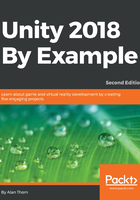
What this book covers
This book explores how to use the Unity engine in a hands-on, practical way by looking at concrete examples that result in real-world playable games. Specifically, it focuses on the implementation of 5 distinct projects divided across 10 chapters, 2 chapters per project. Let's take a look at what these projects are:
Chapter 1, Unity Fundamentals, begins our journey into Unity by creating a first-person collection game. This is a great starting point if you're totally new to Unity and are ready to create your first game.
Chapter 2, Creating a Collection Game, continues from the previous chapter and completes the first project. It assumes that you have completed the first chapter and brings a closure to our project, leading neatly to the next chapter.
Chapter 3, Creating A Space Shooter, marks the beginning of our second project, focusing on the creation of a space shooter game. Here, we'll create a project in which the player must shoot the oncoming enemies.
Chapter 4, Continuing the Space Shooter, completes the space shooter project, taking the project from its state in the previous chapter and adding final touches to it.
Chapter 5, Creating a 2D Adventure Game, enters the world of 2D and UI functionality. Here, we'll explore Unity's wide range of 2D features in making a side-view platformer game that relies on 2D physics.
Chapter 6, Continuing the 2D Adventure, completes the 2D adventure game project that was started in the previous chapter, adding the final touches and linking it together with the overarching game logic. This is a great place to see how multiple parts and facets of a game come together to form a whole.
Chapter 7, Creating Artificial Intelligence, focuses on artificial intelligence and creating enemies that can patrol, chase, and attack the player's character at relevant times, while cleverly navigating their way around the level.
Chapter 8, Continuing with Intelligent Enemies, brings closure to the AI project started in the previous chapter. Here, we'll see how to use finite-state machines to achieve powerful intelligence functionality that'll help us in a variety of scenarios.
Chapter 9, Entering Virtual Reality, explores how to create a first-person shooter in VR where the player must tackle waves on oncoming enemies. In this chapter, we'll lay the foundations for creating a VR game.
Chapter 10, Completing the VR Game, completes the VR project by adding gameplay elements, core functionality, and by creating a build.
Appendix, Test Your Knowledge Answers, the answers to the Test Your Knowledge section of each chapter.